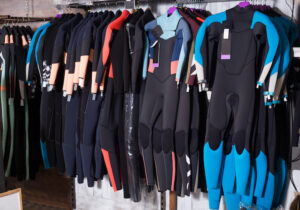Scuba diving is a lot of fun and has become one of the most popular hobbies over the years. However, to ensure that this hobby is carried out safely, it is important to make the right preparations. After all, diving into the depths of the sea always carries certain risks.
For this reason, it is advisable to not only have a basic scuba training and the right equipment, but also to take a look at the diving table. Diving tables help you plan your dive and show you how long you can stay at a certain depth before you should return to the surface. In this article, you will learn why diving tables are indispensable and how to use them.
In this article, you will get answers to the following questions:
- What is a diving table, and why is it important to use one?
- How do you use a diving table, and what are the most essential terms to learn?
- Which diving tables are the most common in the world of scuba diving?
- And what is the difference between a dive computer and a classic diving table?
What is a diving table?
Diving tables are a great tool. They contain valuable information that serves to make the dive as safe as possible and to support divers in their exploration in the depths of the sea. Classic diving tables often come in the form of printed booklets or cards that divers refer to before jumping into the water. But what exactly can be found on these tables?
First and foremost, diving tables show divers how long they can dive at a certain depth. In addition, with the help of a diving table, divers can determine how much oxygen they need for the dive and in what intervals they should resurface. Diving tables are therefore a small but essential tool that every diver should familiarize themselves with.
One of the most widely used diving tables is the “NAUI” diving table (National Association of Underwater Instructors). It consists of the letters A to L with each of these letters representing a certain amount of residual nitrogen in the body. Thus, the letter A represents a small amount of nitrogen, while the letter L represents a large amount.
How to calculate dive tables can quickly become an overwhelming task, especially for beginners. But don’t worry, once you understand the principle behind it, you will see how simple it is. But more on that later. First, let’s take a look at why diving tables are so important and why they should be part of every diver’s basic equipment.
That’s why dive tables are important
Diving tables originated in the US Navy, where they are still used today to prevent a serious illness that often occurs when divers absorb too much nitrogen: decompression sickness.
Diving tables have since made their way from the US Navy to the general diving community and are now used to make scuba diving as safe as possible, where they primarily help scuba divers minimize the risk of decompression sickness. However, it is essential to note that the risk cannot be completely eliminated, even with the use of diving tables.
Diving tables are great because they help divers plan their dive as effectively as possible. They indicate how long divers can stay at a certain depth and how much oxygen is required for the dive. They also provide guidance on how quickly and at what intervals divers should ascend. Additionally, they can be used to calculate the amount of residual nitrogen in the blood after a dive.
Dive tables are important because they:
- help to plan the dive, making it safer and more enjoyable
- help minimize the risk of decompression sickness
- are an essential component of a scuba certification
Now that we know why diving tables are so important, let us have a look at the most important terms when it comes to using one.
Diving table – The important terms
Learning how to read a diving table takes some time, but is definitely not as complicated as you might think. So, to get you started on your educational journey, we created a list with the most essential terms to consider.
Caution:
Please note that different diving tables might each use different terms and definitions. The following list refers to the terms used in “NAUI” tables.
The most important terms:
Dive Schedule
A dive schedule is a short statement indicating the depth and time of a dive, expressed as depth/time, such as “21 meters/40 minutes” or “70 feet/40 minutes”. It’s also known as a dive profile, especially when it’s one dive among several.
Decompression Stop
A Decompression Stop is a point during ascent where you stop at a specified depth for a certain time to allow nitrogen to off-gas before continuing your ascent or surfacing.
A Precautionary Decompression Stop is a safety stop made at 5 meters (ca. 16 feet) for 3 minutes when you haven’t exceeded the Maximum Dive Time. You should do this stop at the end of every dive.
A Required Decompression Stop is the time specified by the NAUI Dive Tables, which you must spend at 5 meters (ca. 16 feet) whenever you exceed the Maximum Dive Time. Other tables indicate additional stop depths for deeper or longer dives.
Maximum Dive Time (MDT)
Maximum Dive Time (MDT) is the time you can spend at a certain depth without needing a required decompression stop during ascent. It’s also called Maximum Allowable Dive Time or no-decompression limit (NDL).
Actual Dive Time (ADT)
Actual Dive Time (ADT) is the time elapsed from the moment you start descending from the surface until you return to the surface. Time spent at your Safety Stop doesn’t need to be included in the Actual Dive Time when determining your Letter Group.
Total Nitrogen Time (TNT)
Total Nitrogen Time (TNT) is the sum of your Residual Nitrogen Time and your Actual Dive Time following a repetitive dive. You use this total to obtain your new Letter Group at the end of the dive.
Residual Nitrogen Time (RNT)
Residual Nitrogen Time (RNT) is the amount of time you must consider as already spent at a given depth for a planned repetitive dive. This time is based on the residual nitrogen remaining in your body from a previous dive or dives.
Surface Interval Time (SIT)
Surface Interval Time (SIT) is the time spent on the surface between dives. During this time, your body is eliminating excess nitrogen. Your Letter Group will change and move closer to the beginning of the alphabet depending on how long you stay on the surface.
Letter Group Designation
A Letter Group Designation identifies the amount of residual nitrogen in your system. The closer the letter is to the beginning of the alphabet, the less residual nitrogen you have in your body.
Residual Nitrogen
Residual Nitrogen is the excess nitrogen remaining in your body from any dive or dives made before you’ve fully off-gassed.
Repetitive Dive
A Repetitive Dive is any dive you make before you’ve fully off-gassed from any previous dive or dives.
How to calculate dive tables?
There are several types of diving tables from different organizations. Although they rely on a similar principle, make sure to carefully study each table and get comfortable reading it before you head out to your underwater expedition.
The NAUI diving tables are amongst the most popular ones and consist of three tables:
- Table 1: End-Of-Dive Letter Group
- Table 2: Surface Interval Time (SIT)
- Table 3: Repetitive Dive Timetable
While reading a diving table, try avoiding using your finger to read it, as you might slide into another row and end up with incorrect data. Instead, use some sort of straight object like a ruler to help you work yourself through the table.
In order to receive the right information from your diving table, you first need to determine the maximum depth of your dive. Once you know the depth, locate it on the left-hand column of the table and find the corresponding time limit for it.
The NAUI diving table also lets you determine the required safety stop for your dive. This is the time needed to eliminate excess nitrogen from the body and should be added to your total dive time.
Based on the time and depth of your time, the NAUI diving table also provides information on the surface interval that is required for your dive. This is the time you need to spend on the water surface between dives in order for your body to eliminate the excess nitrogen.
Next to that, NAUI has a list of important rules every scuba diver should consider.
Rules, every scuba diver should consider:
- When ascending during a dive, do not go faster than 9 meters (ca. 30 feet) per minute, which is equivalent to 0.3 meters (1 foot) every two seconds. Use a timing device and depth gauge or dive computer to monitor your ascent rate.
- Plan your dive according to the closest or next highest number listed in the table for your depth and time.
- Always consider the deepest point of your dive when planning repetitive dives, and make the deepest dive first.
- Wait for a surface interval of at least 10 minutes, but it’s better to wait for at least an hour, between dives.
- If you are having a particularly cold or strenuous dive, use the next highest dive time.
- Avoid reaching the no-decompression limit and give yourself enough time for a slow and comfortable ascent with plenty of air to prevent decompression sickness.
PADI dive table
Next to NAUI diving tables, PADI (Professional Association of Diving Instructors) tables are widely spread in the scuba diving world. Similar to the NAUI tables, they provide divers with the recommended no-decompression limits and adjust for factors such as time, depth of dive, number of dives and cold water that need to be taken into account by the diver.
The PADI dive tables consist of two sets of tables: The Recreational Dive Planner (RDP) and the Wheel version of the RDP. The RDP tables are used to plan single and repetitive dives, while the Wheel version is a more compact version of the tables that divers can take with them underwater.
The RDP tables contain two types of tables – the No-Decompression Limit (NDL) table and the Surface Interval Credit (SIC) table. Similar to the NAUI table, the NDL table provides divers with information on how long they can stay at a certain depth without requiring decompression stops. The SIC table provides information on how long a diver must wait on the surface between dives to allow nitrogen absorption to decrease sufficiently.
Dive tables vs. dive computer
Of course, the era of digitalization has not left the world of scuba diving untouched. While traditional dive tables in the form of booklets or cards do their job perfectly fine, dive computers offer some additional advantages. They have existed since the 80s and have since been able to improve the diving experience for many.
The advantages of dive computers:
- constant adjustment of maximum allowed bottom time based on actual dive profile
- allows diver to stay at a depth of 30 meters/100 feet for well over 1 hour instead of 20-minute bottom time with diving table
- eliminates human error
As you see, there are several benefits when using dive computers. However, there are also some shortages that you might want to consider before buying one.
The disadvantages of dive computers:
- high price
- risk of dive computer falling during dive
- can be complex to operate, especially as they differ greatly among each other
Conclusion: How are dive tables used?
Diving tables provide valuable information that make your exploration in the deep blue sea safer and thus more enjoyable. They usually consist of various tables and provide divers with the recommended no-decompression limits and adjust for factors such as time, depth of dive, number of dives and cold water. While classic diving tables often come in the form of printed booklets or cards, dive computers can offer a great alternative with some advantages and disadvantages attached to them. No matter which type of diving table you use, they are an essential tool that should guide you whenever you plan your next dive.








